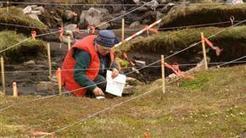The Viking Archaeology Blog is concerned with news reports featuring Viking period archaeology. It was primarily constructed as a source for the University of Oxford Online Course in Viking Archaeology: Vikings: Raiders, Traders and Settlers. For news reports for general European archaeology, go to The Archaeology of Europe News Blog.
Saturday 24 November 2012
Ottawa researcher’s firing derails Viking project
This should be the best of times for Pat Sutherland. November’s issue of National Geographic magazine and a documentary airing Thursday night on CBC’s The Nature of Things both highlight research the Ottawa archeologist has been doing in the Canadian Arctic for the past dozen years that could fundamentally alter our understanding of our early history.
If Sutherland is right, Norse seafarers — popularly known as Vikings — built an outpost on Baffin Island, now called Nanook, centuries before Columbus blundered on to North America. Moreover, there’s evidence they traded with the Dorset, the Arctic’s ancient, now-vanished inhabitants, for as many as 400 years.
”That’s incredible,” says Andrew Gregg, who wrote, directed and produced The Norse: An Arctic Mystery, the CBC documentary that recounts Sutherland’s findings. “That rewrites all the history books.”
But Sutherland’s pleasure at the recognition her discoveries are receiving has been sharply tempered by a harsh reality. Last April, even as the documentary about her work was being filmed, the 63-year-old, then curator of Arctic archeology at the Canadian Museum of Civilization, was abruptly dismissed from her job.
At the same time, museum officials also stripped her husband, Robert McGhee — himself a legendary Arctic archeologist described as “one of the most eminent scholars that Canada has produced” — of the emeritus status it had granted him after his retirement from the Gatineau museum in 2008.
Read the rest of this article...
Tuesday 20 November 2012
How Vikings killed time
The Vikings played ball, lifted stones and wrestled. Often the games turned violent and bloody, occasionally resulting in death.
When Viking men played their games, the women watched - except in drinking games. This is a scene from at saga play in Steigen, Norway. (Photo: Mari Pedersen)
Life in the Viking Age was tough and hard, and physical work filled much of their days, but their lives were not without leisure.In a new study, Leszek Gardela uses archaeological findings and careful reading of Viking sagas to describe how Vikings killed time when they were in mood for entertainment.
The archaeologist paints a vivid picture of Viking life, but the familiarity of many of the activities suggests that while Vikings had shorter lives and arguably vented their frustrations in more violent ways than what most people do today, leisure time in the Viking Age was not too different from leisure time in 2012.
Read the rest of this article...
Greenland's viking settlers gorged on seals
Archaeologists dig up skeletons of Norse settlers in 2010 at the Norse farm Ø64,
Igaliku Fjord, Østerbygden, Greenland. Photo: Jette Arneborg
UNSOLVED MYSTERY
Greenland's viking settlers, the Norse, disappeared suddenly and mysteriously from Greenland about 500 years ago. Natural disasters, climate change and the inability to adapt have all been proposed as theories to explain their disappearance. But now a Danish-Canadian research team has demonstrated the Norse society did not die out due to an inability to adapt to the Greenlandic diet: an isotopic analysis of their bones shows they ate plenty of seals.“Our analysis shows that the Norse in Greenland ate lots of food from the sea, especially seals,” says Jan Heinemeier, Institute of Physics and Astronomy, Aarhus University.
“Even though the Norse are traditionally thought of as farmers, they adapted quickly to the Arctic environment and the unique hunting opportunities. During the period they were in Greenland, the Norse ate gradually more seals. By the 14th century, seals made up between 50 and 80 per cent of their diet.”
Read the rest of this article...
Sunday 18 November 2012
Summer Courses in Archaeology
Oxford Experience Archaeology Courses
The Oxford Experience Summer
School offers weekly introductory courses in the Sciences and Humanities. Participants stay in Christ Church, the
largest and one of the most beautiful Oxford Colleges.
Thursday 8 November 2012
Should we keep the Vikings’ stolen goods?
Made in Scotland or Ireland toward the end of the eighth century, the
original purpose of Ranvaik’s chest had been to house the bones of a
Christian saint.
(Photo: National Museum of Denmark)
Ranvaik’s golden chest was made in Ireland or Scotland toward the end of the eighth century and originates from a church or a monastery.
"Ranvaik owns this shrine" the inscription on the bottom reads, as a strong indication that it later came to belong to a noble Viking lady named Ranvaik.
Archaeologists believe that the shrine, which can be admired at the Danish National Museum, is stolen property from the Viking Age.
”Viking Age objects that come from churches and monasteries can best be explained as loot from the raids which made the Vikings notorious in the Christian world,” explains Maria Panum Baastrup, an archaeologist at the National Museum’s Prehistoric Collection.
Read the rest of this article...
Subscribe to:
Posts (Atom)




